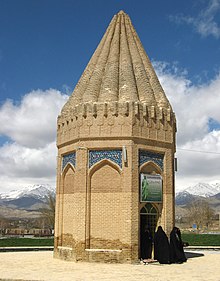The Tomb of Prophet Habakkuk (Persian: آرامگاه حبقوق نبی) is a historic mausoleum located in the city of Tuyserkan, Iran. It is number 969 on the list of national monuments of Iran. The mausoleum is believed to entomb the remains of the biblical prophet Habakkuk, who is revered in some Islamic traditions as one of the Prophets of Bani Israil.
| Tomb of Prophet Habakkuk | |
|---|---|
 | |
| Religion | |
| Affiliation | Twelver Shi'a, Judaism |
| Province | Hamadan Province |
| Location | |
| Location | Tuyserkan, Iran |
| Geographic coordinates | 34°33′06″N 48°25′48″E / 34.5516921°N 48.4299650°E |
| Architecture | |
| Type | mausoleum |
| Style | Seljuk |
| Completed | 13th century |
| Specifications | |
| Height (max) | 12 metres |
| Dome height (outer) | 7 metres |
History
editThe mausoleum was built during the Seljuk period, in the 13th century.[1][2] Local traditions lay claims that the site was originally a pre-Islamic tomb dedicated to Habakkuk as well.[1][2] Regardless of claims about the site, the mausoleum has always been revered by both the Shi'ites and the community of Iranian Jews. It has also been restored many times since its first construction.
In 1372, illegal looters tunneled under the mausoleum to steal antiques.[2] In later years, these tunnels were investigated during excavation works, and it was discovered that there was a crypt below the mausoleum, where the actual tomb was found.[1][2] Several legends also describe the discovery of the body of Habakkuk there, which appeared to have been well-preserved.[1][2]
In the 20th century, the mausoleum was listed as a national monument of Iran.[1][2]
Architecture
editThe mausoleum is octagonal in shape from the ground up and made of brick. It is 12 metres in height.[2] The dome that tops the mausoleum is built in a unique conical formation, with a height of 7 metres.[1][2] On the exterior, Jewish motifs like the Star of David are subtly visible as part of the exterior designs.[1][2] The purported grave of Habakkuk is located underneath the dome.[1][2]
At some point, four towers and a gate existed around the mausoleum.[1][2] The ruins of such objects were found during archeological excavations.[1][2]
